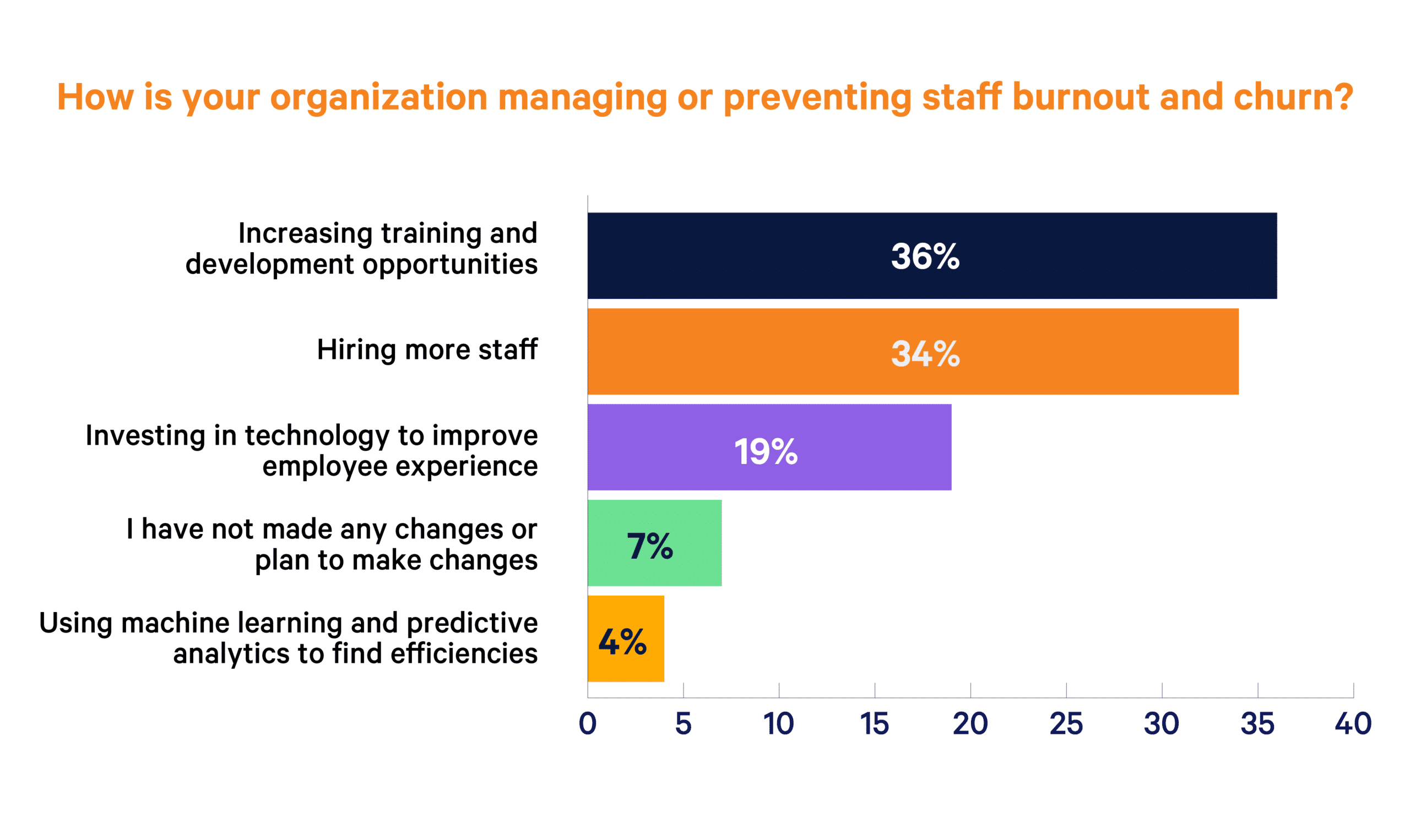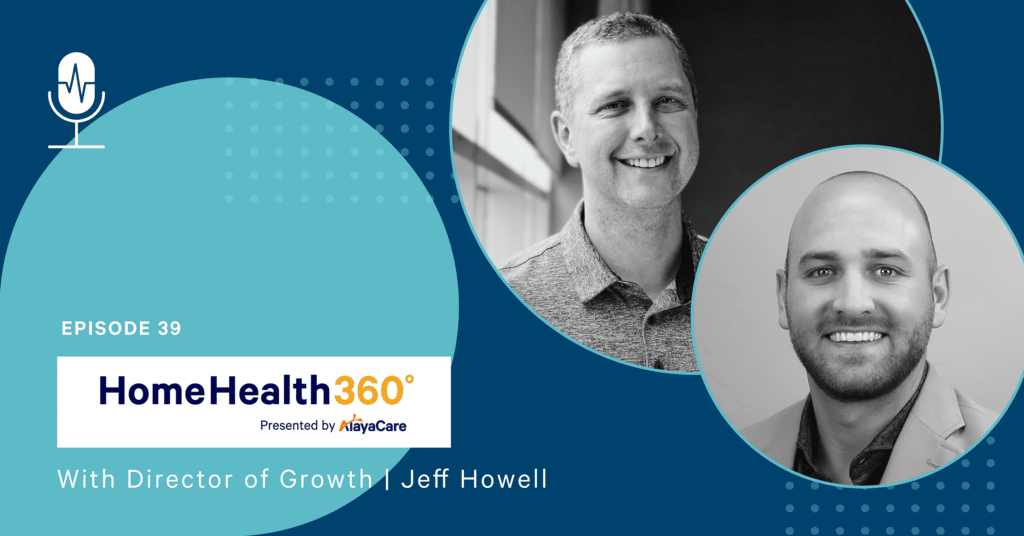Blog
6 ways your home-based care staff can increase caregiver retention

A major challenge and significant pain point of any business is the retention of employees. How to retain caregivers continues to be the main question agencies are asking as they shift their focus to growth. Many home care agencies are adapting to meet the needs of their caregivers to improve caregiver satisfaction.
Based on a caregiver recruitment and retention survey conducted by AlayaCare and Home Health Care News (HHCN), caregiver turnover was identified as a top business inefficiency.
From a business perspective, employee turnover can reduce the quality of care provided and increase operational costs for home care agencies. For these reasons, home care agencies must make a real effort to identify and have disciplined practices to address caregiver turnover.
What have home-based care organizations identified as the top reasons for employee churn?
- Inconsistent schedules
- Lack of proper training, development, and/or growth opportunities
- Lack of proper resources and/or tech supporting job function
The responses provided context and revealed what some agencies believe to be the reasons why caregivers are burnt out.

How can I increase my caregiver retention?
According to the survey report, to prevent staff burnout and employee churn, some home care providers are increasing training and development opportunities, hiring more staff, and/or investing in technology to improve the employee experience…but there’s more to it than just that!
Retaining qualified home care employees during this caregiver staffing crisis has been a challenge for most home-based care organizations. For starters, listening to employee feedback and learning about their challenges and why caregivers leave is the first step to improving employee satisfaction, and in return employee retention.
Here are 6 ways to increase caregiver retention in home-based care…
1. Creating professional development opportunities
89% of employees who had an effective onboarding experience are engaged at work and are 30x more likely to feel overall job satisfaction compared to employees who feel their onboarding process was lacking, according to BambooHR.
If caregivers need further learning opportunities, they need help from their managers and employers. There are several factors that are considered from the growth point of view of an employee; many caregivers look at training opportunities to support career advancement.
Regardless of certification, you need to ensure your caregiver learns and grows in your organization, which would increase their skills in handling diverse situations, delivering quality care, and establishing safety for clients.
Consider e-learning tools or online training and development
Providing ongoing training was one of the top strategies home care agencies were implementing. There are a number of training and development resources available that allow home care agencies to provide easy access to certifications for their workforce. Training and development is especially important at a time when providers are competing with other hospitality industries for talent.
There are many online home care training and education companies, such as CareAcademy or Nevvon, that specialize in providing home care agencies with the tools to provide their caregivers with proper training and career development.
Maximizing efficiency and quality care through training programs with Home Care Pulse

Capture and use data for employee development and growth
Harness the power of data to fuel your employee development and growth in the home care industry. By strategically capturing and analyzing data, you can pinpoint the gaps contributing to caregiver turnover. Armed with this knowledge, devise targeted improvement strategies to boost retention, fostering a stable, motivated workforce.
Take AlayaCare’s Employee Retention Dashboard as an example, it tracks key metrics to help spot the warning signs of churn. The satisfaction score model then predicts which employees are at risk of churning giving you an opportunity to monitor and identify trends that can help you apply targeted retention strategies.
Digital onboarding
Another building block for retaining caregivers is providing a thorough onboarding experience to train new employees faster and more efficiently. Digital onboarding and learning management systems can get new caregivers up to speed faster by offering a guided experience of what to expect in a digestible format. Combined with in-person connections, this creates a memorable experience that helps caregivers feel welcomed and prepared.
Webinar: Creative strategies and tools to boost caregiver satisfaction
Industry experts from Caribou, Nevvon, Tapcheck, and AlayaCare explore the latest creative strategies and tools that your home care organization can start using to boost caregiver satisfaction and improve retention.
Read our recap blog for a quick summary!
2. Employees more often leave managers, not companies
Your leadership’s management styles will influence your caregivers’ engagement at work. The top complaint from caregivers is ‘lack of communication with the agency’.
Effective communication is the key to any effective caregiver retention strategy. When you create an open and honest work environment that communicates clearly, your workers will feel more comfortable and will go to you whenever they need to.
Build effective communication skills
The top complaint from caregivers is ‘lack of communication with the agency’. Effective communication is the key to any effective caregiver retention strategy. When you create an open and honest work environment that communicates clearly, your workers will feel more comfortable and will go to you whenever they need to.
Helping caregivers feel like part of the team
Employers and managers should interact with their staff more often and make a conscious effort to make them feel part of the team. The fact is, if the Outreach Coordinator isn’t often able to contact your caregivers, they’ll feel less important thus increasing the turnover rate.
Consistent contact and acknowledgment with your caregivers are important. Imagine how it feels to go to an in-person training session with someone who you’ve barely heard from. Even though this may be a small thing, it is going to help people feel part of a team.
Ask for feedback and act on it promptly
Regularly asking for feedback from your home care team and listening is crucial in developing an effective two-way communication plan based on the individual and team’s needs in general. If managers aren’t contacted regarding complaints and concerns, then their caregiver is likely not that interested in voicing them.
Or if managers don’t take action or take too long to reply to voiced complaints and concerns from caregivers, then eventually these experienced caregivers may find employment opportunities elsewhere. The right culture to ask questions and respond immediately will increase caregiver retention.
3. Manage client-caregiver relationships more effectively
Creating a strong relationship can significantly improve caregiver retention among clients. Caregivers may be dissatisfied with their job performance if there have been ongoing conflicts or negative relationships between the client and others, while others will try another agency to get away from their ‘poor’ client.
The majority of agencies are even going to exonerate clients who were ill-prepared and lacked professionalism. If you want to keep the team healthy, you must support the caregivers.
4. Pay competitively
A company paying competitively will be better able to secure more competent care workers in a competitive market. The agencies that are attractive to caregivers are those that consistently make a conscious effort to provide competitive pay and benefits.
In some instances, gaining more money may prove difficult for business owners. It must determine whether the company will increase client rates and reduce margins. The best way to determine whether a company has the flexibility to increase rates is to see how many clients have to leave for a week because they lack caregiver support.
5. Eliminate inconsistent scheduling
- Caregivers have voiced that they wish to work for an agency that provides reliable and flexible shifts without having to travel too far between clients
- Schedulers wish to fulfill a high volume of vacancies and scheduling requests now and in the future as efficiently and as accurately as possible
- Agency leaders have voiced that they want to retain and satisfy their caregiver workforce, their clients and manage costs to scale their agency
“There are a few reasons for the churn, and one is that it’s a tough job. But the number one reason through research and interviews is their schedules. They are not being given enough hours to make this into a full-time job so that they can feed their families.”
Naomi Goldapple, SVP of Data and Intelligence, AlayaCare
The turnover rate is about 80%, and replacing an employee can cost over $4,500 USD in resources.
One solutions to improving inconsistent schedules is a visit optimization tool.
How technology can help with inconsistent scheduling
Leveraging optimization technologies as decision support tools can assist all stakeholders to achieve their goals. Here’s what you can expect if you invest in a visit optimization tool:
- Streamlined processes by minimizing manual effort and reducing reliance on guesswork, freeing up administrative staff to focus on high-priority tasks.
- Saved time spent searching, matching and negotiating with caregivers to fill vacant visits.
- Minimized time caregivers spend on travel and associated mileage costs and maximize time spent on direct patient care.
- Improved caregiver retention by eliminating the risk of human bias in scheduling. Utilize your entire workforce to reduce overworked caregivers.
- Ensured balanced workload for care providers by selecting the best match based on skillsets, proximity to client and other selected criteria.
Imagine having consistent, reliable, and flexible scheduling for your caregivers? Finding a visit optimization tool can help solve your scheduling issues and tackle one of the biggest reasons for caregiver turnover.
Hear from Choice Healthcare on how they reduced each scheduling task by at least 20 minutes:
6. Ensure your caregivers are not stressed and have all the resources needed for their job
Overburdening of caregivers on the job can often come from the lack of resources and technical support for your caregivers’ job function.
Only 19% of providers say they have invested in technology to help with employee churn. Yet, one of the biggest pain points for caregivers is the lack of technical support they need to perform their jobs.
Therefore, agencies can support a caregiver’s daily job with the right technology can help provide them with the right resources when they need them most.
Mobile apps
We live in an age where everyone carries a mobile device on their person. Why not use its potential to make your caregiver’s job easier?
Smart, mobile technology can prevent employee churn by easing caregivers of stressful tasks. Tasks like manual reporting after each patient visit can lead to burnout.
Flexible, user-friendly software enables agencies to shift in any new direction desired. Now, agencies can embrace emerging styles of care and deploy modern tools such as working offline with no wifi.
See how caregiver Mitzi uses mobile apps to do her visits easily and efficiently:
Electronic billing
Manual billing and invoicing are tedious tasks that take up a great amount of time. Technology makes billing practices far more efficient by cutting down on manual processes. Wouldn’t it be better to have a tool that makes invoicing and billing easier and faster? So the caregivers can focus more time on the patients and less on administrative tasks?
Clinical electronic documentation
One of the most complained about repetitive tasks by care providers is documentation. Manually uploading clinical documentation and forms not only takes up time but can be a hassle.
Having a tool that simplifies the administrative tasks like documentation. It can reduce delays as clinical staff will be able to upload charts in real-time. It can also set-up and build any report into a digital format all with a secure documentation cloud-based system (HIPAA and PHIPA compliant).
With electronic charting and documentation within home care software, all the information caregivers need is in one place. By minimizing data entry and improving report generation with automation, agencies can increase the accuracy of clinical document efficiency.
Eliminate the hassle of paper processes that can cause frustration with staff, with electronic documentation.
Acclaim Health was able to reap the benefits of reducing paperwork with a home care software system, AlayaCare Cloud. They initially used 48K of paper per month. They reduced it by 90% of 4800 sheets of paper per month since going digital.

In the field, you want any technology to be intuitive and fast, to not frustrate caregivers or take too much time away from client care. Scheduling tools that provide visibility into the organization’s shifts can also empower caregivers to pick the times that work for them or avoid lengthy drives or gaps in their day. They can even pick up extra shifts with one click.
On the back end, tech opens a precision window into a caregiver’s overall satisfaction levels. Machine learning algorithms can generate satisfaction scores that help you uncover the root causes of churn — and how to proactively address them.
Want to learn more about recruitment and retention from industry experts? Watch the webinar below!





